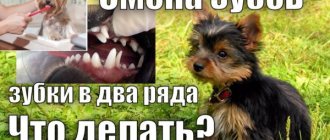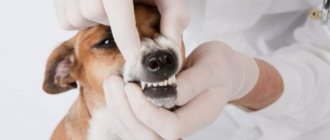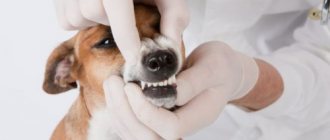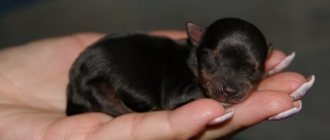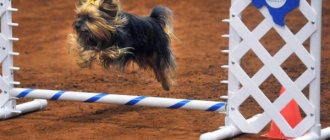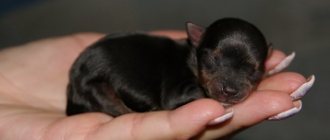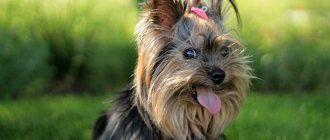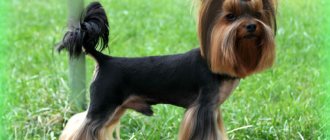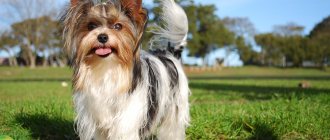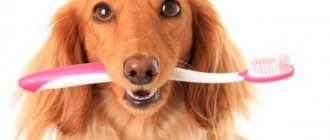Healthy teeth and correct bite in a Yorkie are not only a sign of good health of the dog, but also a source of pride for its owner. Unfortunately, not all Yorkies can boast of even, snow-white fangs. If your pet is not looked after too carefully, its teeth become covered with plaque, which over time hardens and turns into tartar.
And problems during the change of teeth in puppies of this breed are not uncommon. Therefore, in order for the dog to develop a correct bite, you need to carefully monitor how the teeth change so as not to miss possible deviations.
Features of the jaw structure
Yorkies are born toothless; around the second week of life, the first fangs appear. At one and a half months, the pet already has a milk dental kit.
Yorkshire Terrier with beautiful teeth
The standard teeth for a puppy are 28 units, after 3 months of age they begin to be replaced by molars. Loss begins with the incisors and canines, and the chewing ones grow last. At this time, the small animal begins to actively gnaw everything due to severe itching of the gums.
By 8 months, 42 permanent teeth grow in place of the first teeth. These include incisors, canines, premolars and molars. To speed up the changing process, you need to let your puppy try hard treats and sticks on his teeth.
For your information! Dogs have 26 chewing premolars and molars, which are the last ones to grow.
Basic questions about changing teeth
Sometimes the molars grow next to the baby teeth, so you need to make sure that they fall out over time. A dog with two rows of teeth has a funny face.
The owner may not notice how many teeth the Yorkshire Terrier loses. Puppies often swallow small teeth; they get lost on the floor or on the street during walks.
Food gets into the empty hole in the gum and rots, and the dog’s mouth smells unpleasant.
Diagram of the arrangement of teeth in a Yorkie's mouth
Possible complications
Dwarf breeds have the hardest time with the change of baby teeth. If your pet is at risk, examine its oral cavity every day so as not to miss warning signs of complications.
Gum inflammation
Accompanied by redness and swelling of the mucous membranes, as well as profuse salivation, which worsens the appearance of the fur on the chest. This complication usually goes away on its own, but sometimes develops into periodontal disease. It can be identified by severe bleeding of the gums and a strong odor from the mouth.
Stuck teeth
Some animals retain 2 rows of teeth at once. This complication is called persistence. It is fraught with increased trauma to the mucous membranes and cheeks, as well as malocclusion.
Be sure to check if your dog has baby teeth next to his molars. If you find two shoots in one hole, contact your veterinarian. Sometimes the problem can be solved by manual loosening, but in most cases surgery cannot be avoided.
Malocclusion
Improper closing of the jaws is typical for breeds with an elongated muzzle: dachshunds, labradors, dobermans, rottweilers. It is facilitated by games of tug of war, feeding exclusively soft food and persistence.
To correct the bite, rubber corrector rings are used that act as braces. If the animal is not a show animal, then it is enough to prevent the situation from worsening and control the position of the jaws.
Malfunctions of the gastrointestinal tract
Quite often, babies experience diarrhea. It is not dangerous, as the stool quickly returns to normal. You should only worry if you experience symptoms of dehydration:
- dry mucous membranes, nose and coat;
- loss of activity and increasing lethargy;
- slow smoothing of skin crumpled into a fold by fingers.
Additionally, vomiting and fever may occur. A pet with such symptoms must be shown to a veterinarian within the first day after their discovery. Otherwise, he may die.
Necessary care
Puppies 1-3 months of age benefit from regular examination of the jaws; future malocclusion can be seen already at this age. If the owner notices a misalignment of the dentition or overlapping of the fangs, he should urgently consult a doctor to correct the pathology.
How many teeth does a dog have: diagram and size of fangs
During the period when a Yorkie's teeth are changing, the owner must provide oral care for the pet. Every 3 days it is necessary to examine the dog's oral cavity. If signs of curvature of incisors, fangs or inflammation of the gums are noticed, the puppy is urgently taken to the clinic.
A growing dog must develop its jaw muscles, which means it should not be fed soft food. The pet's jaws are actively working, chewing cartilage, vegetables and dry food.
Important! When changing teeth, you need to look into your pet's mouth several times a week. In case of injuries and inflammation of the gums, the dog is taken to the doctor.
Advantages and disadvantages
In addition to their compact size, which allows Yorkies to feel comfortable living even in small apartments, and visual appeal, representatives of this breed have many more advantages:
- devotion and loyalty to the owner;
- ability to get along with children;
- ability to learn;
- friendliness, lack of anger or aggression;
- intelligence, intelligence and the ability to make independent decisions, assessing the current situation.
An important fact is the absence of undercoat in Yorkies and, accordingly, shedding, as well as the hypoallergenic nature of their coat.
NOTE!
Before purchasing a dog, allergy sufferers need to find out what exactly provokes an allergic reaction: if the problem is in the animal’s skin secretions, they should not buy a Yorkie.
Yorkies also have disadvantages, including:
- intolerance of loneliness;
- the need for careful and expensive care;
- imperfect digestive system, requiring a special diet;
- tendency to allergies.
Read more about the pros and cons of the breed here.
Yorkies also require clothing and shoes for walking in the cold season (shown in the photo).
Side effects
Molars should grow in place of milk teeth. If this does not happen, the cause is sought in poor nutrition or genetic diseases.
How many teeth does a cat have: diagram of the jaw of an adult cat
A pet can grow several permanent fangs at once next to the milk ones. An abnormal number of incisors in the jaw leads to deformation of the bone tissue.
For your information! Teeth can become deformed due to a lack of calcium in the body or head injuries.
A dog's teeth grow in 2 rows
Remnants of food and infection become clogged into the hole of the fallen root; this can lead to suppuration of the gums and an inflammatory process. In the worst case, the Yorkie will lose adjacent teeth. Inflammation causes discomfort for the dog, and restless behavior is a symptom of pain.
What are they?
The dog's dental system consists of incisors, canines, false roots and molars, as well as premolars and molars. The first premolars are deciduous and are replaced by permanent ones at the age of 4-5 months. But molars are only permanent and are absent in puppies.
In total, adult dogs have the following set of teeth:
- Twelve incisors (6 each on the upper and lower jaws).
- Four fangs (2 on each jaw).
- Sixteen premolars (8 each above and below).
- Ten molars (4 on the upper and 6 on the lower).
The first of the premolars, located immediately behind the canine, is usually very small in size; it also happens that in place of one of these teeth, a dog grows two.
Types of malocclusion
If the change of teeth in a Yorkie is not complete, the jaw may become deformed, the incisors and canines will grow in the wrong direction. Ideally, all breeds should have a scissor bite. In this case, the lower canines, when the jaws close, are located between the last incisor and the upper canine.
Correct scissor bite in a dog
When a Yorkie's teeth fall out with a long delay or when problems occur, the bite deteriorates. There are several types of malocclusion.
- The dog may have a snack. This is when the lower jaw protrudes significantly forward compared to the lower jaw. The problem is treated by removing some premolars;
- with underbite there is a large gap of more than 3 mm between the closed jaws. Visual description of underbite - the lower part of the mouth is shorter than the upper;
- There are pathologies of the jaw - too narrow or short. In a deformed row, the teeth are fanned out or layered on top of each other.
Important! With any type of malocclusion, the animal will subsequently have problems with roots and chewing food. The young dog needs to be shown to the doctor so that he can help correct the dentition. Sometimes permanent canines and molars have to be pulled out to straighten the jaw.
Visit to the veterinarian
The sooner your Yorkie starts visiting a canine orthodontist, the faster he will get used to dental procedures. The doctor will remove baby canines and incisors, install a device to straighten the teeth, correct the bite, and give recommendations for cleaning the pet’s mouth.
The dog is shown to the doctor even before the temporary teeth are replaced. The specialist will assess the condition of the animal’s jaw and give a forecast about the Yorkie’s future bite.
An adult is taken to the clinic 2 times a year to have tartar cleaned. Deposits are removed using a laser; the operation is painless.
Yorkshire Terrier at a doctor's appointment
Diagnostics
Most people aged 50 years and older experience the physiological type of abrasion. The doctor needs to determine in time when the natural process turns into a pathological one. One of the main methods remains measuring the actual parameters of crowns. In addition, it is important to carefully study the shape of the dental units and determine areas of contact with antagonists. The height of the coronal part is compared with age standards established scientifically.
Diagnostic measures include assessment of fissures and enamel condition. The doctor pays attention to the patient’s facial expressions and appearance. It is important to talk in detail about your complaints and describe your feelings.
To assess how correctly the temporomandibular joint functions, electromyography is indicated. X-ray examination, electroodontodiagnosis and other procedures are carried out.
Possible problems
Adults with an incomplete set of teeth are often found. Mostly they are missing back molars. This deficiency does not affect the quality of life, but such a dog will no longer be accepted for exhibition.
The most common problem for a miniature dog is that the baby incisors may never fall out. As the pet grows, the milky root softens and a permanent incisor grows in its place. If the root part does not change, the permanent tooth grows nearby, and the milk tooth remains in the socket. The excess element in the jaw must be removed, otherwise it will cause pain to the dog.
Is it possible to replace brushing your Yorkie's mouth with treats?
Promotions of various dog treats will not leave anyone indifferent. They are said to completely clean the incisors and promote oral hygiene. This also applies to dry food. It is a mistake to believe that since dry food promotes jaw development, then the dog does not need anything else. This is only partly true, because no amount of treats or bones can replace brushing your teeth.
At least once every week or two, thoroughly clean your Yorkie's mouth. This will help avoid bad breath, tartar formation and yellow plaque. And for extra care, use vet-approved treats.
How often to brush your Yorkie's teeth
Yorkie's baby teeth are brushed 3 times a week, and permanent teeth every day. To clean, use dog toothpaste and a short-bristled brush. You can use a light solution of baking soda.
Note! To self-clean the enamel, pets are allowed to chew on young carrots, dried offal, and pumpkin.
Cleaning a small dog's incisors
Removal of milk
Incorrect positioning of teeth is not only a spoiled appearance. These include digestive problems, but also damage to the dog’s tongue and gums. To prevent this from happening, retained baby teeth must be removed in a timely manner. To do this, it is best to go to a veterinary clinic, where the doctor will easily and painlessly relieve your pet of this problem. This is a quick and uncomplicated procedure that is performed under local or general anesthesia. In order to eliminate the possibility of complications, it is recommended to examine the animal before the procedure and carry out the necessary tests.
Preventive health procedures
To maintain oral health, dogs need to have tartar removed. This is done using special pastes or in the veterinarian's office. Plaque on enamel can lead to inflammation of the gums and loss of incisors. Once every 2 weeks, small dogs need to put anti-gum gel into the oral cavity.
Important! Young dogs are not allowed to play tug games. Forceful loading on the jaw can deform it.
During the active change of the dentition, the dog should not be allowed to gnaw on very hard bones, metal objects and stones. They can deform soft, unformed gums.
It is necessary to periodically inspect the mouth of a young Yorkie. An even dentition and a standard number of teeth will help not only win prizes at exhibitions, but also maintain the health of the animal. Cleaning and removing stones will save your small pet’s chewing apparatus. You shouldn’t lead to possible problems.
Helping dogs with the eruption of permanent teeth
To help puppies with problematic teeth and keep the furniture safe and sound, you need to take care of special toys in a timely manner. For example, these could be teethers; they are sold in any pet store. Or you can give the puppies a thick stick; they will happily chew on it and play with it.
To prevent gum inflammation, the owner needs to examine the mouth of his little four-legged friends every day. If during the examination problems were identified, for example, redness and bleeding of the gums, the appearance of an unpleasant odor from the mouth, discoloration of the teeth, then you should immediately show the animal to a doctor.
To reduce teething discomfort, you can give puppies tasty treats to chew on:
- bones or sticks;
- meat moslaki, boiled or raw cartilage;
- raw vegetables;
- dry wood from a fruit tree.
